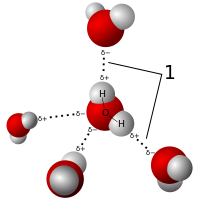
Photo from wikipedia
Understanding the noncovalent interactions (NCIs) among the residues of proteins and nucleic acids, and between drugs and proteins/nucleic acids, etc., has extraordinary relevance in biomolecular structure and function. It helps… Click to show full abstract
Understanding the noncovalent interactions (NCIs) among the residues of proteins and nucleic acids, and between drugs and proteins/nucleic acids, etc., has extraordinary relevance in biomolecular structure and function. It helps in interpreting the dynamics of complex biological systems and enzymatic activity, which is esential for new drug design and efficient drug delivery. NCIs like hydrogen bonding (H-bonding) and π-stacking have been researchers' delight for a long time. Prominent among the recently discovered NCIs are halogen, chalcogen, pnictogen, tetrel, carbo-hydrogen, and spodium bonding, and n → π* interaction. These NCIs have caught the imaginations of various research groups in recent years while explaining several chemical and biological processes. At this stage, a holistic view of these new ideas and findings lying scattered can undoubtedly trigger our minds to explore more. The present review attempts to address NCIs beyond H-bonding and π-stacking, which are mainly n → σ*, n → π* and σ → σ* type interactions. Five of the seven NCIs mentioned earlier are linked to five non-inert end groups of the modern periodic table. Halogen (group-17) bonding is one of the oldest and most explored NCIs, which finds its relevance in biomolecules due to the phase correction and inhibitory properties of halogens. Chalcogen (group 16) bonding serves as a redox-active functional group of different active sites of enzymes and acts as a nucleophile in proteases and phosphates. Pnictogen (group 15), tetrel (group 14), triel (group 13) and spodium (group 12) bonding does exist in biomolecules. The n → π* interactions are linked to backbone carbonyl groups and protein side chains. Thus, they are crucial in determining the conformational stability of the secondary structures in proteins. In addition, a more recently discovered to and fro σ → σ* type interaction, namely carbo-hydrogen bonding, is also present in protein-ligand systems. This review summarizes these grand epiphanies routinely used to elucidate the structure and dynamics of biomolecules, their enzymatic activities, and their application in drug discovery. It also briefs about the future perspectives and challenges posed to the spectroscopists and theoreticians.
Journal Title: Chemical Society reviews
Year Published: 2022
Link to full text (if available)
Share on Social Media: Sign Up to like & get
recommendations!